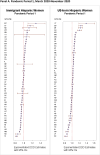Hard Hit: The impact of the COVID-19 pandemic on childbearing in the Hispanic/Latino population
- PMID: 40677905
- PMCID: PMC12268934
- DOI: 10.1016/j.ssmph.2025.101831
Hard Hit: The impact of the COVID-19 pandemic on childbearing in the Hispanic/Latino population
Abstract
Objectives: The alarmingly disproportionate impact of COVID-19 on the working age segment of the Hispanic/Latino population motivates our focus on determining whether the COVID-19 pandemic differentially impacted the fertility of Hispanic women compared to non-Hispanic White women.
Methods: Leveraging state-level birth count data, we perform an interrupted time-series (ITS) analysis using state-specific, piece-wise regression models to assess pandemic impacts on fertility across five different pre- and post-pandemic periods for U.S.-born Hispanic women, immigrant Hispanic women, and non-Hispanic white women. We present difference-in-differences (DiD) estimates to assess the impact of the pandemic on births to each group of women and difference-in-difference-in-differences (DDD) estimates to determine if U.S.-born or immigrant Hispanic women experienced more pronounced pandemic fertility impacts compared to their non-Hispanic White counterparts.
Results: There was substantial variability in both pre- and post-pandemic fertility trends by state and population sub-group. We find that immigrant Hispanic women in nearly all states had fewer births than expected from March 2020 through February 2021, irrespective of pre-pandemic fertility trends. In contrast, non-Hispanic white women in most states experienced a "baby boomlet" from December 2020 through December 2022. U.S.-born Hispanic women have a more variable pattern during this period, with fewer births than expected in about half of the states, and a "baby boomlet" in the other half. Relative to non-Hispanic whites, however, both groups of Hispanic women experienced more pronounced depressive pandemic impacts on fertility at the height of the pandemic (December 2020-February 2021).
Discussion: Mirroring disproportionate impacts on mortality, in the case of fertility, in nearly all states, foreign-born Hispanic Americans experienced pronounced and disproportionately negative impacts on births from December 2020 through February 2021, followed by a baby boomlet through December 2022. Establishing these patterns is a critical piece of a full accounting of the extent of the pandemic's influence on our country's demography, particularly how it has altered the population processes of such hard-hit sub-populations as Hispanic Americans.
© 2025 The Authors. Published by Elsevier Ltd.
Conflict of interest statement
The authors declare that they have no known competing financial interests or personal relationships that could have appeared to influence the work reported in this article.
Figures







Similar articles
-
Signs and symptoms to determine if a patient presenting in primary care or hospital outpatient settings has COVID-19.Cochrane Database Syst Rev. 2022 May 20;5(5):CD013665. doi: 10.1002/14651858.CD013665.pub3. Cochrane Database Syst Rev. 2022. PMID: 35593186 Free PMC article.
-
Understanding patient pathways to Mother and Baby Units: a longitudinal retrospective service evaluation in the UK.Health Soc Care Deliv Res. 2025 Jul 16:1-17. doi: 10.3310/GDVS2427. Online ahead of print. Health Soc Care Deliv Res. 2025. PMID: 40682791
-
Pain management for women in labour: an overview of systematic reviews.Cochrane Database Syst Rev. 2012 Mar 14;2012(3):CD009234. doi: 10.1002/14651858.CD009234.pub2. Cochrane Database Syst Rev. 2012. PMID: 22419342 Free PMC article.
-
Measures implemented in the school setting to contain the COVID-19 pandemic.Cochrane Database Syst Rev. 2022 Jan 17;1(1):CD015029. doi: 10.1002/14651858.CD015029. Cochrane Database Syst Rev. 2022. Update in: Cochrane Database Syst Rev. 2024 May 2;5:CD015029. doi: 10.1002/14651858.CD015029.pub2. PMID: 35037252 Free PMC article. Updated.
-
The Black Book of Psychotropic Dosing and Monitoring.Psychopharmacol Bull. 2024 Jul 8;54(3):8-59. Psychopharmacol Bull. 2024. PMID: 38993656 Free PMC article. Review.
References
LinkOut - more resources
Full Text Sources
Research Materials

